Chimney device for a fireplace: general provisions + installation on the example of a steel version
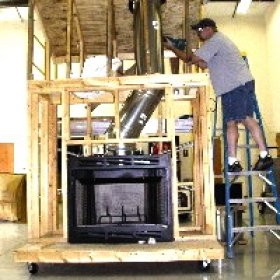
Correctly arranging a chimney for a fireplace is perhaps more important than even picking up and installing the fireplace itself. Errors can lead to equipment breakdowns, as well as the risk of fire, poisoning by combustion products, etc. The choice of chimney flues is quite wide: from a traditional brick pipe with a steel liner to elegant glass structures that organically fit into the most modern interior.
Content
Chimney requirements and design options
The task of the chimney is the removal of fuel combustion products. This means that the structure will warm up to a very high temperature, while in contact with aggressive chemicals formed during combustion. Another problem is the condensation of water vapor, which inevitably appears due to temperature differences. Therefore, for the installation of a chimney chimney, the most durable materials are used, depending on which the following types of chimneys are distinguished: brick, steel, ceramic and glass.
Option # 1 - brick chimney
Brick chimney is made of masonry. This is the least expensive option for the removal of combustion products, but, alas, not the most effective. Masonry is a laborious process. Inside such a chimney, a special steel insert should be inserted, which will improve the removal of smoke.
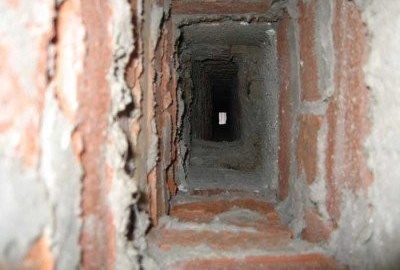
Previously, a brick chimney was just brickwork. To date, such a chimney is rarely arranged. If you see someone with a brick option, then most likely it is a steel chimney, lined with brick
Option # 2 - steel chimney
The steel chimney is a round pipe made of stainless or galvanized steel, equipped with a heater and an external circuit. It is quite simple to install and has a relatively low physical weight.
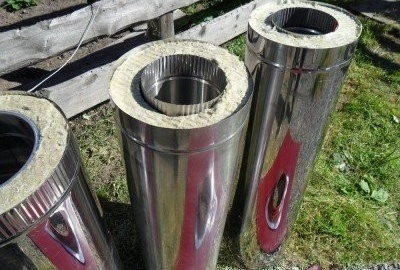
The steel chimney for the fireplace consists of internal and external circuits, between which a layer of insulation is laid. Such a chimney is very easy to install
A galvanized pipe costs slightly less than a stainless steel construction, but experts caution that such savings can lead to a situation where “the avaricious pays twice.” The smoke removal loads are so high that when choosing which chimney is better for the fireplace, it is more advisable to stop at a more expensive, but corrosion-resistant "stainless steel".
When choosing sandwich chimneys, pay attention to three main indicators: the grade of stainless steel of the inner contour, the thickness of the thermal insulation and its material.
Option # 3 - ceramic chimney
Installation of such a design It requires some training and accuracy.The sophisticated chimney device for the fireplace provides excellent thermal insulation, as well as a long service life of about 30 years.
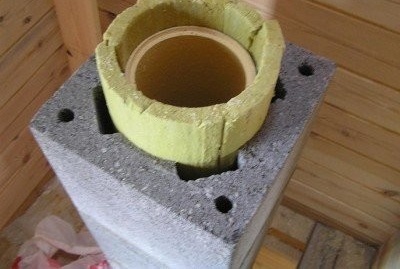
A ceramic chimney consists of three layers: an inner liner of ceramic, an outer layer of lightweight concrete blocks and a heat-insulating gasket that fits between these layers
Option # 4 - glass chimney
Glass is the most expensive and complex option, but such a design looks very impressive in the interior. Resistance to corrosion, heat and moisture - the undoubted "advantages" of glass chimneys.
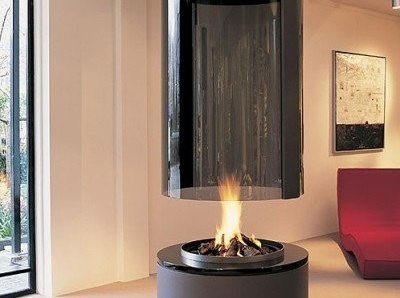
Glass chimney for a fireplace is expensive, but it looks great in the interior and has excellent performance characteristics. Installation of such a design is best entrusted to professionals
Another important aspect is good traction. To do this, the chimney channel, if possible, should be strictly vertical, and its walls should be as smooth and absolutely airtight as possible.
Accommodation, sizes and other nuances
Think about the device of the fireplace in the house should be at the design stage. For example, you should consider that the material of walls and floors should be non-combustible. You can ask for help with drawing up a diagram of the chimney of the fireplace to the measurer of the company supplying the chimney. This service is not free, but it should be noted that corporate installation can cost an amount comparable to the cost of a good firebox.
It is also recommended to place the chimney in the warm part of the building. If circumstances are such that the structure is located near a cold exterior wall, additional thermal insulation should be taken into account. The closer the chimney is to the ridge of the roof, the smaller will be the size of the pipe towering above the roof.
The diameter of the chimney pipe for the fireplace should correspond to the diameter of the flue pipe. If this condition is violated, traction disturbances or incomplete removal of combustion products are possible. The minimum height of the chimney should be four meters. The pipe must rise at least 500 mm above the flat roof. The same dimensions are acceptable if the distance to the roof ridge does not exceed half a meter. If the pipe is located at a distance of 1.5-3 meters from the ridge, its height should reach the level of the ridge.
Installation example of a steel chimney
Before you make a steel chimney for the fireplace, you need to carry out some preparatory work. First you need to install a fireplace insert. If special legs are not provided, such a support should be made independently of metal, fireclay brick, stone, etc. The distance from the furnace to the wall should be 150 mm, given that the thickness of the insulation layer is 50 mm.
Note! The wall adjacent to the fireplace needs thermal insulation, which can be done with foil basalt wool. Some experts believe that the most suitable material for such work is exclusively mineral wool made in Denmark, withstanding heat up to 700 degrees.
After the position of the furnace is determined, it should be armed with a plumb line and determine the axis of the exhaust outlet of the furnace. The axis of the chimney chimney must completely coincide with it. Now it should be noted the projection of the furnace on the adjacent wall, as well as on the floor. If the firebox is located on a metal stand, the support should be covered with a layer of refractory paint. Under the legs of the support, you need to put pieces of brick so that its position corresponds to the level of flooring. A good idea for such a support is legs, the length of which can be adjusted.
It is possible to start the installation of the chimney only after the furnace is placed in the place intended for it, and its position is carefully verified vertically and horizontally, and then fixed with a metal corner.
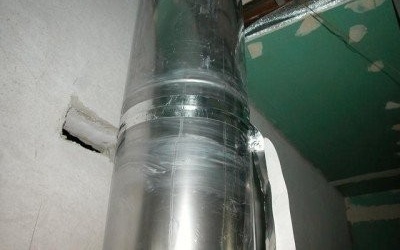
After the connection of the elements of the steel chimney for the fireplace with sealant and rivets is completed, the connection is wrapped with aluminum tape
Now you can proceed with the installation of the chimney. First, seal all the internal seams of the chimney with a sealant. Then begin the assembly of its elements from the bottom up. A double layer of sealant is applied in a circle to the joints of the individual elements of the chimney. First connect the inner circuit, and then the outer. In this case, the upper element of the inner contour should go inside the lower element, and not vice versa. This will prevent condensation from entering the insulation. The outer contour is fixed with rivets, then the joints and rivets are glued with aluminum tape. In this case, it is necessary to ensure that the joints of the elements of the chimney do not fall under the thickness of the floor.
Note! The insulation at the joints does not always fit snugly enough. During operation, a sufficiently strong heating of the external circuit can occur. You can avoid this problem if you put an additional layer of insulation at the joints.
Particular attention deserves the correct fastening of the chimney. To fix the pipe, the outer contour is crimped with a special clamp, which is fixed with rivets. Then the clamp is fixed to the ceiling using a special corner and fixing bolts. In this case, the main weight of the chimney flue should not fall on the base of the fireplace insert, but on the clamps and corners fixed to the ceilings.
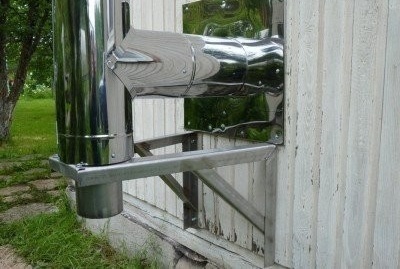
After the connection of the elements of the steel chimney for the fireplace with sealant and rivets is completed, the connection is wrapped with aluminum tape
When attaching a steel chimney, the possibility of thermal expansion of the metal during heating should be taken into account. To compensate for this process, a special flexible element should be installed in the lower part of the first section of the chimney flue. If such a part is missing, it is necessary to provide a clearance of about 1-1.5 cm when securing the clamps at the corners, so that the structure can move during thermal expansion. If the chimney circuit is fixed rigidly, then during operation the lower section of the structure will be squeezed down, which can lead to damage to the equipment.
As they say, it's better to see once than hear a hundred times. Therefore, here is a video with useful tips from an experienced stove maker:
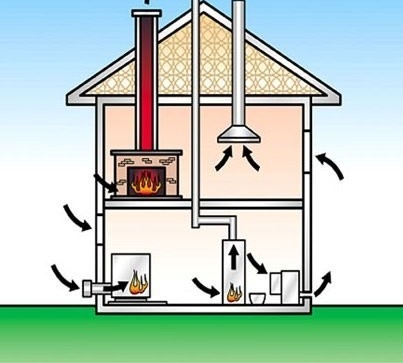

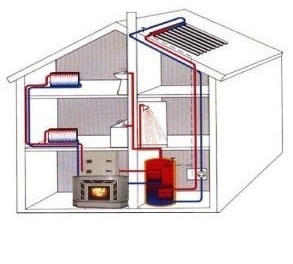
3 comments